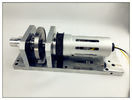
loading
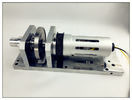

| Quantity: | |
| Place of Origin | China |
|---|---|
| Brand Name | RPS-SONIC |
| Certification | CE |
| Model Number | RPS-S800 |
| Minimum Order Quantity | 1set |
| Price | negotiation |
| Packaging Details | FOAM AND CARTON |
| Delivery Time | 5days |
| Payment Terms | T/T, Western Union, MoneyGram, paypal |
| Supply Ability | 500 sets per month |
| Name | Ultrasonic Sewing Machine | Frequency | 35khz |
|---|---|---|---|
| Power | 800W | Horn Material | Rapid Steel,Titanium |
| Generator | Digital | ||
| High Light | ultrasonic sealing machine,ultrasonic seam welding equipment | ||
Ultrasonic bonding is the process of using high-frequency compression/relaxation of materials against specially designed anvil patterns that cause them to heat at the molecular level and melt.
A systematic experimental and numerical combined study of the thermomechanical
bonding mechanisms in the ultrasonic welding (UW) process was conducted. A fully coupled thermomechanical finite element model has been built to fully understand the evolution and coupling between the in-process thermomechanical variables. The severe, localized, plastic deformation at the bond region is believed to be the major phenomenon for bond formation in ultrasonic welding. The influences of substrate dimensions on bond formation were studied and explained with an analytical vibration model. The formation of banded and cyclic stress-strain maxima in the substrate was found to be caused by superposition of vibrations. A push-pin type, combined experimental and numerical, method has been developed, validated, and applied to quantitatively determine the bond strength of UW parts. The best bond strength produced using the set of process parameters in this study was 75% of the ultimate tensile strength of the base material (Al3003-H18). Effects of UW parameters (normal pressure, vibration amplitude, and travel velocity) on bond strength have been characterized. Due to the weak vertical bond strength of UW parts, the pressurized post-weld heat treatment (PWHT) approach is originally proposed to improve the bond strength. The results show that the modified bond strength, up to 96% of the strength of the base material, can be achieved under the optimum parameters of 2.5 MPa pressure, 450 ◦C temperature, and 1.5 h time.
This process enables the materials to flow around the shapes of the anvil and adhere to each other and to other materials that are in the web matrix. It is only a part of the ultrasonic sewing machine.
It need be assembled on the ulltrasonic sewing machine, and drive by an other rotary horn.
Characteristics:
1. Seamming,trimming and embossing without glue, thread or other consumables
2. More faster and cost effective than traditional sewing machine and adhesive ways
3. Eliminates fraying or unraveling of bonded edges and seams
4. Multifunctional and thousands of designs available
5. Requires minimum training and maintenance
6. Super strong ultrasonic power meets the needs of different fabric thickness
The ultrasonic rotary process (welding wheel and horn rotating on a parallel axis), allows a perfect sliding of the fabric to get:
· Waterproof welding
· Cut and weld assembly
· Regular welding
· Multiple patterns …
| Item | Parameter |
| Frequency | 35KHZ |
| Power | 800W |
| Rotary horn diameter | 106MM |
| Amplitude | 28μm |
| Rotary horn material | Rapid steel,Titanium |
| Speed | 0.1-5m/s |
| Electrical tension: | 220 V single phase, 50 or 60 Hz |
| Welding width | 8mm |
Instead of needles, thread, glues or other adhesives, ultrasonic sewing equipment uses a patented rotary system, coupled with high-frequency vibrations, to bond synthetic or blended materials containing up to 40 percent natural fibers.
Resembling a traditional sewing machine, the ultrasonic sewing machine channels the ultrasonic vibrations between a horn and rotating wheel, producing a localized heat buildup which causes the synthetic fibers to soften and fuse. This creates a strong molecular bond that’s impervious to moisture. Explains Alleman, “the resulting barrier seams are sealed, secure, ultra-reliable and soft-to-the-touch without the safety issues caused by stitch holes, glue gaps, fraying or unraveling.”
OUR SHOWHOUSE
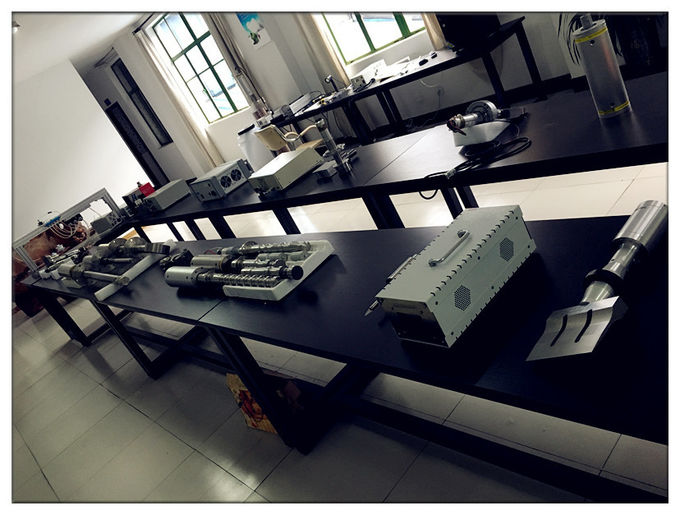
TESTING DESK
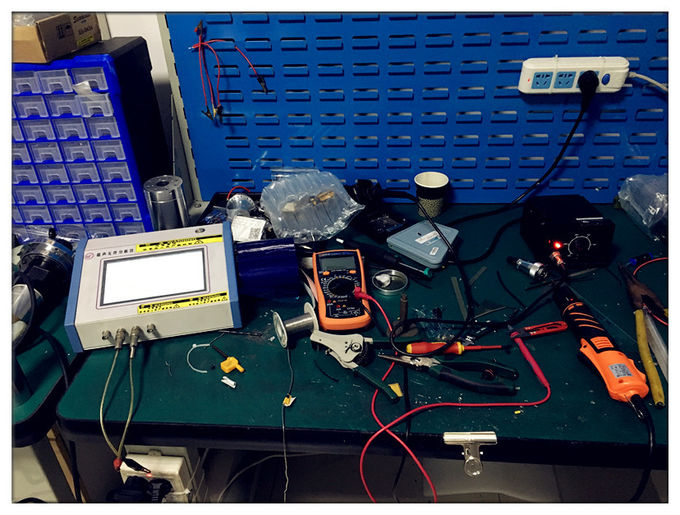
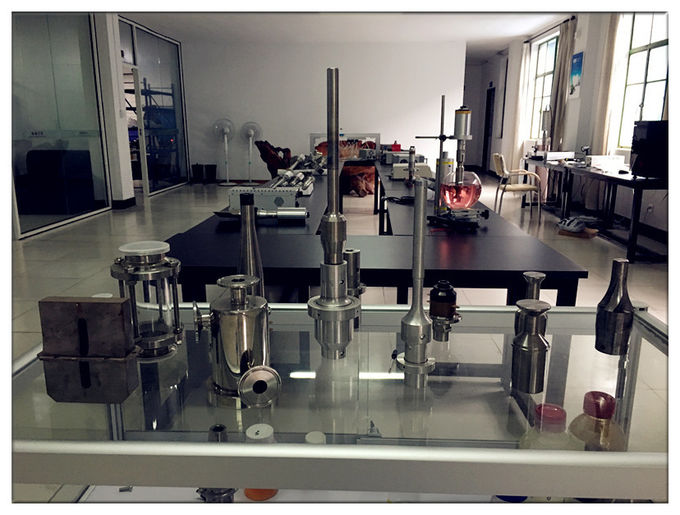
| Name | Ultrasonic Sewing Machine | Frequency | 35khz |
|---|---|---|---|
| Power | 800W | Horn Material | Rapid Steel,Titanium |
| Generator | Digital | ||
| High Light | ultrasonic sealing machine,ultrasonic seam welding equipment | ||
Ultrasonic bonding is the process of using high-frequency compression/relaxation of materials against specially designed anvil patterns that cause them to heat at the molecular level and melt.
A systematic experimental and numerical combined study of the thermomechanical
bonding mechanisms in the ultrasonic welding (UW) process was conducted. A fully coupled thermomechanical finite element model has been built to fully understand the evolution and coupling between the in-process thermomechanical variables. The severe, localized, plastic deformation at the bond region is believed to be the major phenomenon for bond formation in ultrasonic welding. The influences of substrate dimensions on bond formation were studied and explained with an analytical vibration model. The formation of banded and cyclic stress-strain maxima in the substrate was found to be caused by superposition of vibrations. A push-pin type, combined experimental and numerical, method has been developed, validated, and applied to quantitatively determine the bond strength of UW parts. The best bond strength produced using the set of process parameters in this study was 75% of the ultimate tensile strength of the base material (Al3003-H18). Effects of UW parameters (normal pressure, vibration amplitude, and travel velocity) on bond strength have been characterized. Due to the weak vertical bond strength of UW parts, the pressurized post-weld heat treatment (PWHT) approach is originally proposed to improve the bond strength. The results show that the modified bond strength, up to 96% of the strength of the base material, can be achieved under the optimum parameters of 2.5 MPa pressure, 450 ◦C temperature, and 1.5 h time.
This process enables the materials to flow around the shapes of the anvil and adhere to each other and to other materials that are in the web matrix. It is only a part of the ultrasonic sewing machine.
It need be assembled on the ulltrasonic sewing machine, and drive by an other rotary horn.
Characteristics:
1. Seamming,trimming and embossing without glue, thread or other consumables
2. More faster and cost effective than traditional sewing machine and adhesive ways
3. Eliminates fraying or unraveling of bonded edges and seams
4. Multifunctional and thousands of designs available
5. Requires minimum training and maintenance
6. Super strong ultrasonic power meets the needs of different fabric thickness
The ultrasonic rotary process (welding wheel and horn rotating on a parallel axis), allows a perfect sliding of the fabric to get:
· Waterproof welding
· Cut and weld assembly
· Regular welding
· Multiple patterns …
| Item | Parameter |
| Frequency | 35KHZ |
| Power | 800W |
| Rotary horn diameter | 106MM |
| Amplitude | 28μm |
| Rotary horn material | Rapid steel,Titanium |
| Speed | 0.1-5m/s |
| Electrical tension: | 220 V single phase, 50 or 60 Hz |
| Welding width | 8mm |
Instead of needles, thread, glues or other adhesives, ultrasonic sewing equipment uses a patented rotary system, coupled with high-frequency vibrations, to bond synthetic or blended materials containing up to 40 percent natural fibers.
Resembling a traditional sewing machine, the ultrasonic sewing machine channels the ultrasonic vibrations between a horn and rotating wheel, producing a localized heat buildup which causes the synthetic fibers to soften and fuse. This creates a strong molecular bond that’s impervious to moisture. Explains Alleman, “the resulting barrier seams are sealed, secure, ultra-reliable and soft-to-the-touch without the safety issues caused by stitch holes, glue gaps, fraying or unraveling.”
OUR SHOWHOUSE

TESTING DESK










Ultrasonic Welding Equipment Ultrasonic Welding Transducer Ultrasonic Welding Converter Ultrasonic Liquid Processor Ultrasonic Cutting Equipment Ultrasonic Spray Nozzles Ultrasonic Power Supply Ultrasonic Soldering Equipment Ultrasonic Welding Horn Ultrasonic Assisted Machining Ultrasonic Testing Equipment
content is empty!